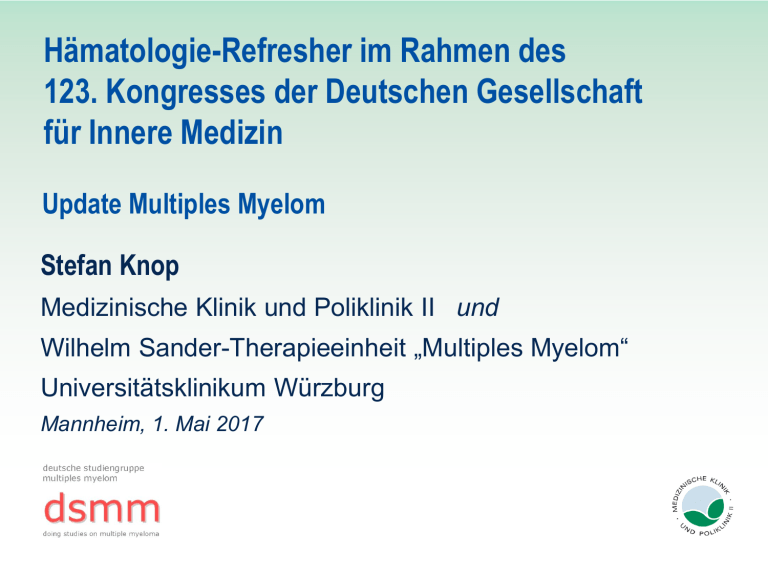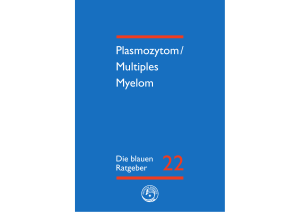Multiples Myelom
Werbung

Hämatologie-Refresher im Rahmen des 123. Kongresses der Deutschen Gesellschaft für Innere Medizin Update Multiples Myelom Stefan Knop Medizinische Klinik und Poliklinik II und Wilhelm Sander-Therapieeinheit „Multiples Myelom“ Universitätsklinikum Würzburg Mannheim, 1. Mai 2017 SPEP und Immunfixation Electric current Myeloma Patient Normal Patient M-spike Amount of protein Albumin (-) Gamma Beta Alpha 1 Alpha2 Albumin 3g/dL Alpha1 Alpha2 Beta Smallest (+) Normal Largest Size of protein Gel Blood and 24-hr urine samples Gamma Protein electrophoresis Patient Serum Patient Urine κ IgG κ light chain Immunofixation electrophoresis Control samples Protein electrophoresis followed by hybridization with antibodies to: IgG, IgA, IgM, κ light chain, λ light chain IgG IgA IgM κ λ Adapted from http://www.mayomedicallaboratories.com/articles/hottopics/transcripts/2009/2009-11b-gammopathies/11b4.html. Accessed August 29, 2012 Aktualisierte IMWG-Kriterien Definition des Multiplen Myeloms Multiples Myelom Mind. 10 % klonale* KM-Plasmazellen oder histolog. gesichertes Plasmozytom und mind. ein “myelomdefinierendes” Ereignis: • Endorganschädigung („CRAB“-Kriterien) durch die zugrundel. Plasmazellerkrankung Hyperkalzämie (> 0,25 mmol/l [1 mg/dl] über oberem Normwert oder > 2,87 mmol/l [> 11 mg/dl]) Niereninsuffizienz (Kreatininclearance < 40 ml/min§ oder Serumkreatinin > 2 mg/dl [177 µmol/l]) Anämie (Hb < 10 g/dl oder 2 g/dl < normal) Osteodestruktion (≥ 1 lytische Läsion in Skelettröntgen, CT oder PET-CT) • „SLiM-CRAB“: Malignitäts-Biomarker Klonale KM-Plasmazellen ≥ 60 % Serum-Leichtkettenquotient (betr./nichtbetr. LK) ≥ 100 >1 fokale Läsion in der MR-Tomographie * Klonalitätsnachweis erforderlich (FACS, Immunhistochemie); KM-PC: vorzugsweise aus der KM-Biopsie, bei Diskrepanz zählt der höhere Wert; § gemessen oder durch entspr. Formel berechnet Rajkumar et al., Lancet Oncol 2014 Multiples Myelom Welche Diagnostik ist nötig? Serum • Elektrolyte (Calcium!), CRP, LDH • Kreatinin, Harnstoff, Harnsäure • • • • Gesamteiweiß, Albumin (vornehmlich Erstdiagnose) b2-Mikroglobulin (nur Erstdiagnose) Serumelektrophorese (Bestimmung des M-Gradienten!) Serum-Immunfixation Urin • • Urin-Teststreifen 24h-Sammelurin (Proteindifferenzierung, Urin-Immunelektrophorese) Knochenmarkdiagnostik • Aspirationszytologie, Knochenmarkstanze (Plasmazellgehalt, LK-Restriktion) • Molekulare Zytogenetik (fließt in ISS-R ein!) Bildgebende Diagnostik • Ganzkörper-low dose-CT (Ausspielung des Knochenfensters) Verlaufskontrollen beim Myelom Mythos und Wahrheit 1. „Measurable disease“: M-Protein > 10 g/l (Serum) und/oder > 200 mg/24h (Sammelurin) 2. Serum-FLC-Test bei/zu: a.) Suche nach Gammopathie zus. mit Serumdiagnostik, Verzicht auf Sammelurin b.) Prognoseabschätzung c.) Kontrolle bei „non-measurable disease“ (s.1.) d.) Speziellen Situationen („light chain escape“) 3. Serum-FLC-Test nicht für Einsatz bei Sammelurin validiert! 4. Serum-FLC-Test bei ca. 80% der Patienten mit intaktem Ig ohne zusätzlichen Wert! © Biochemica Medica Zugelassene Möglichkeiten 2017 Konventionelle Chemotherapie • Melphalan, Adriamycin, Bendamustin, etc. HD-Chemotherapie • Einfache ASCT Monoklonale Antikörper • Elotuzumab • • • Tandem ASCT Allogene SCT • RIC Proteasominhibitoren • Bortezomib • Carfilzomib • Ixazomib Immunmodulator. Substanzen (IMiDs) • Thalidomid • Lenalidomid • Pomalidomid Daratumumab Isatuximab, MOR-202 Anti-PD-1-(Nivolumab)/anti-PD-L1-Ak (Durvalumab) Histon-Deacetylasehemmer • Panobinostat Bcl-2-Inhibitoren • Venetoclax BRAF-Inhibitoren • Vemurafenib Adoptiver T-Zelltransfer • BCMA CAR T-Zellen • CTL019 CAR T-Zellen


